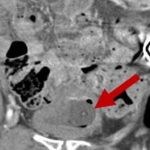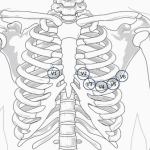Holy Foley
A Rare Case of Iatrogenic Obstruction
by Adam Heilmann, MD; Jessica Pelletier, DO; Jennifer Reyes Lin, MD, MPH
Explore This Issue
ACEP Now: Vol 43 – No 10 – October 2024Our patient is a 33-year-old male with spastic quadriparesis due to cerebral palsy with chronic indwelling suprapubic catheter (SPC) who presented to the emergency department (ED) due to concern for Foley catheter obstruction. The patients’ mother has attempted to flush the SPC multiple times unsuccessfully at home. The catheter was reportedly due for an exchange the following week. The patient reports pain at the site of SPC but denied fevers, nausea, vomiting, or other systemic symptoms. SPC was exchanged in the ED with clear yellow fluid observed draining into the bag. The patient was discharged with return precautions; however, he returned nine days later with a migraine, emesis, and fever with Tmax of 38 degrees Celsius at home. At the time of evaluation, all symptoms had resolved. SPC was able to be flushed and laboratory evaluation included blood count, metabolic panel and urinalysis, all of which were unremarkable other than suspicion for urinary bacterial colonization. The patient was ultimately discharged home with return precautions and SPC was not exchanged. Two days later, the patient returned for a third time with a fever and new, sharp left flank pain.
Click here for the full article!
I Have a Bad Feeling About This
Putting clinical gestalt to work in the emergency department
by Alex Koo, MD, FACEP
Gestalt is useful in areas of time-sensitivity and uncertainty. Sound familiar? This is the essence of emergency medicine. Caring for critically ill patients with limited information requires snap assessments and judgements for timely resuscitation and efficient emergency department throughput.
Click here for the full article!
Danger Swimming Below the Surface
A common cause of sudden cardiac arrest in a child
by Jay Pershad, MD, FACEP; Stephanie Lacey, DO
A 10-year-old male with a past medical history significant for autism spectrum disorder and 15q3 deletion, experienced a cardiac arrest at home. There was no family history of syncope or sudden death. EMS found the patient pulseless and apneic, with an initial rhythm showing ventricular fibrillation. He was defibrillated twice and received 2 doses of epinephrine, with return of spontaneous circulation.
Click here for the full article!
Advocating for Patients
EM physicians and residents advocate for our patients at the highest court in the nation
by Karen Hou Chung, MD; Neha Gupta, MD; Breanne Jacobs, MD
Pages: 1 2 | Single Page


No Responses to “October Issue Online Exclusives”